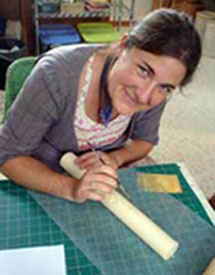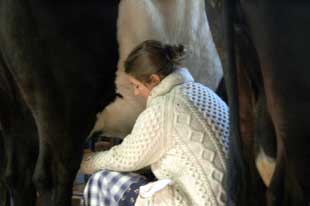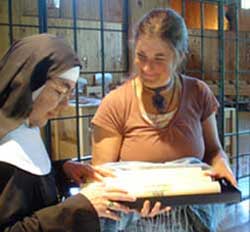|
|
 CRAFT AND THE HOLINESS OF MATTER
CRAFT AND THE HOLINESS OF MATTER
by Brenna Cussen, Monastic Intern
The voice of the Church comes to us like a challenge: we are to shout aloud our belief in the dignity and holiness of material things; we are to affirm our faith and our hope in te future of man’s flesh…The doctrine of the Assumption is of supreme importance not only to Catholics but to all men and women because it means that there is still in the world, there will always be in the world, a voice to affirm and a power to defend the dignity and the ultimate glory of matter, of material things, of human flesh and blood, of the lovely mystery of human love, of the beauty which is the work of men’s hands.
Gerald Vann (The Water and the Fire)
For most of my twenty-nine years of life as a Catholic, the question of whether or not Mary was assumed into heaven was not a significant factor in my faith. As a member of the Catholic Worker movement for the last nine years, often the strongest points of entry for me into Catholicism, after the Eucharist, have been the mandates as a Church to embody the Sermon on the Mount, to perform the Works of Mercy, and to love our enemies.  The Assumption was to me one of several teachings of the Church that, while I didn’t necessarily disagree with it, seemed tangential to the heart of the Gospel. The Assumption was to me one of several teachings of the Church that, while I didn’t necessarily disagree with it, seemed tangential to the heart of the Gospel.
This past year, however, since spending time at the Abbey of Regina Laudis and experiencing the rhythm of work and prayer of cloistered Benedicine nuns, my understanding of the Assumption has been transformed. I have become infinitely grateful for the Church’s emphasis on the sanctity of the body, and Its insistence on the way that matter participates in our salvation. I have begun to internalize the mystery of the holiness of material things, and am in awe at the gift we have been given as human beings to become co-creators with God. The practical reason for my coming to the Abbey was to prepare for starting one of the “agronomic universities” envisioned by Peter Maurin, co-founder of the Catholic Worker movement. Taking some time away from the daily demands of hospitality, I hoped to concentrate on learning skills in agricultural work and craftsmanship that would bring me one step closer to that dream. Living at the Abbey, I am able to keep a regular rhythm of ora et labora (work and prayer): attending daily Mass and Vespers, working on the land, gardening, milking cows, keeping bees, baking bread, making cheese, and, most dear to me of all, learning the craft of pouring and dipping candles.
 Laboring with my hands, using my body to participate in these acts of creation, has infused me with a new understanding of the relationship of man to work. I am beginning to understand Maurin’s conviction that it is necessary for human beings to perform manual labor, “to use all of himself,” in order to make him a “whole man and a holy man.” Peter Maurin was convinced of the necessity to utilize man’s creativity and intellect to make beautiful and useful things. He knew that in a society “where it is easier for people to be good,” a society filled with happy, healthy human beings, people would need to be able to use both their minds and their bodies to invent and to create. In The Long Loneliness, the story of Dorothy Day’s conversion, Dorothy wrote of Peter that he “rejoiced to see men do great things and dream great dreams. He wanted them to stretch out their arms to their brothers, because he knew that the surest way to find God, to find the good, was through one’s brothers. Peter wanted this striving to result in a better physical life in which all men would be able to fulfill themselves, develop their capacities for love and worship, expressed in all the arts. He wanted them to be able to produce what was needed in the way of homes, food, clothing, so that there was enough of these necessities for everyone. A synthesis of ‘cult, culture and cultivation.’” Maurin’s vision of a green revolution was concerned not only with the societal evils of joblessness and over-consumption (he loved to say, “there is no unemployment on the land” and “eat what you raise and raise what you eat”), but also with the dignity of the human being, a dignity which comes through work that integrates both manual labor and creativity. Laboring with my hands, using my body to participate in these acts of creation, has infused me with a new understanding of the relationship of man to work. I am beginning to understand Maurin’s conviction that it is necessary for human beings to perform manual labor, “to use all of himself,” in order to make him a “whole man and a holy man.” Peter Maurin was convinced of the necessity to utilize man’s creativity and intellect to make beautiful and useful things. He knew that in a society “where it is easier for people to be good,” a society filled with happy, healthy human beings, people would need to be able to use both their minds and their bodies to invent and to create. In The Long Loneliness, the story of Dorothy Day’s conversion, Dorothy wrote of Peter that he “rejoiced to see men do great things and dream great dreams. He wanted them to stretch out their arms to their brothers, because he knew that the surest way to find God, to find the good, was through one’s brothers. Peter wanted this striving to result in a better physical life in which all men would be able to fulfill themselves, develop their capacities for love and worship, expressed in all the arts. He wanted them to be able to produce what was needed in the way of homes, food, clothing, so that there was enough of these necessities for everyone. A synthesis of ‘cult, culture and cultivation.’” Maurin’s vision of a green revolution was concerned not only with the societal evils of joblessness and over-consumption (he loved to say, “there is no unemployment on the land” and “eat what you raise and raise what you eat”), but also with the dignity of the human being, a dignity which comes through work that integrates both manual labor and creativity.
 Many of Maurin’s ideas on craft and labor he attributed to Russian Anarchist Peter Kropotkin, who in his central work, Fields, Factories, and Workshops, emphasized the importance of the “integration of labor” to cure the ills with which capitalism’s “division of labor” has plagued the world. Kropotkin recognized that the efficiency and profitability of the division of labor came at a great cost to the well-being of man: “The worker whose task has been specialised by the permanent division of labor has lost the intellectual interest in his labor, and it is especially so in the great industries: he has lost his inventive powers.” Kropotkin posited that each nation would be more likely to thrive if it were made up of individuals who could work in the field as well as in “some industrial art; each individual combining scientific knowledge with knowledge of a handicraft.” He held the hope that society’s love affair with division of labor would soon be substituted with “a variety of pursuits – intellectual, industrial, and agricultural – corresponding to the different capacities of the individual, as well as to the variety of capacities within every human aggregate.” Kropotkin believed that men were at their best when they exercised both their body and their mind, and were able to see an entire process through from its start to finish. As for education, he imagined that a robust society would need to teach “both science and handicraft from earliest childhood” in order to “give to society the men and women it really needs.” Many of Maurin’s ideas on craft and labor he attributed to Russian Anarchist Peter Kropotkin, who in his central work, Fields, Factories, and Workshops, emphasized the importance of the “integration of labor” to cure the ills with which capitalism’s “division of labor” has plagued the world. Kropotkin recognized that the efficiency and profitability of the division of labor came at a great cost to the well-being of man: “The worker whose task has been specialised by the permanent division of labor has lost the intellectual interest in his labor, and it is especially so in the great industries: he has lost his inventive powers.” Kropotkin posited that each nation would be more likely to thrive if it were made up of individuals who could work in the field as well as in “some industrial art; each individual combining scientific knowledge with knowledge of a handicraft.” He held the hope that society’s love affair with division of labor would soon be substituted with “a variety of pursuits – intellectual, industrial, and agricultural – corresponding to the different capacities of the individual, as well as to the variety of capacities within every human aggregate.” Kropotkin believed that men were at their best when they exercised both their body and their mind, and were able to see an entire process through from its start to finish. As for education, he imagined that a robust society would need to teach “both science and handicraft from earliest childhood” in order to “give to society the men and women it really needs.”
 Maurin was also a disciple of Benedictine spirituality, which appreciates the need in human beings for both the rhythm of manual labor and creativity. The Benedictine way of life recognizes that a person will be much more fulfilled in doing the “drudgery”of work if she also participates in the ultimate beauty of the final product. For example, waking up early every day to milk the cows and clean the barn feels more rewarding to the woman who later stretches the mozzarella and churns the ice cream. Taking care of the bee garden is more of a joy to the one who knows what it is like to extract golden honey from the frames, and to render beeswax that she will later use to make the Paschal candle. Dorothy Day’s journals, published in The Duty of Delight, reveal her own gratitude for the Church’s emphasis on the material: “Stained glass windows, statues, flowers, and pure bees’ wax candles, incense, the organ and the choir when they have them, all these appeals to the senses contributes to devotion and the sense of mystery and awe.” Dorothy also said, “We had a wayfarer who accepted our hospitality for a few years who used to kneel down and kiss the earth (on the Feast of the Annunciation) each year, because Christ, in putting on our human flesh, which came from the earth, had made that earth holy.”The Catholic Church’s faith in the reality of the Incarnation, the Assumption, and the Resurrection of the Body are the foundation of Her unique way of integrating matter into the story of our salvation. Practicing craftmanship is a way for us to live this story. Maurin was also a disciple of Benedictine spirituality, which appreciates the need in human beings for both the rhythm of manual labor and creativity. The Benedictine way of life recognizes that a person will be much more fulfilled in doing the “drudgery”of work if she also participates in the ultimate beauty of the final product. For example, waking up early every day to milk the cows and clean the barn feels more rewarding to the woman who later stretches the mozzarella and churns the ice cream. Taking care of the bee garden is more of a joy to the one who knows what it is like to extract golden honey from the frames, and to render beeswax that she will later use to make the Paschal candle. Dorothy Day’s journals, published in The Duty of Delight, reveal her own gratitude for the Church’s emphasis on the material: “Stained glass windows, statues, flowers, and pure bees’ wax candles, incense, the organ and the choir when they have them, all these appeals to the senses contributes to devotion and the sense of mystery and awe.” Dorothy also said, “We had a wayfarer who accepted our hospitality for a few years who used to kneel down and kiss the earth (on the Feast of the Annunciation) each year, because Christ, in putting on our human flesh, which came from the earth, had made that earth holy.”The Catholic Church’s faith in the reality of the Incarnation, the Assumption, and the Resurrection of the Body are the foundation of Her unique way of integrating matter into the story of our salvation. Practicing craftmanship is a way for us to live this story.
|


 CRAFT AND THE HOLINESS OF MATTER
CRAFT AND THE HOLINESS OF MATTER